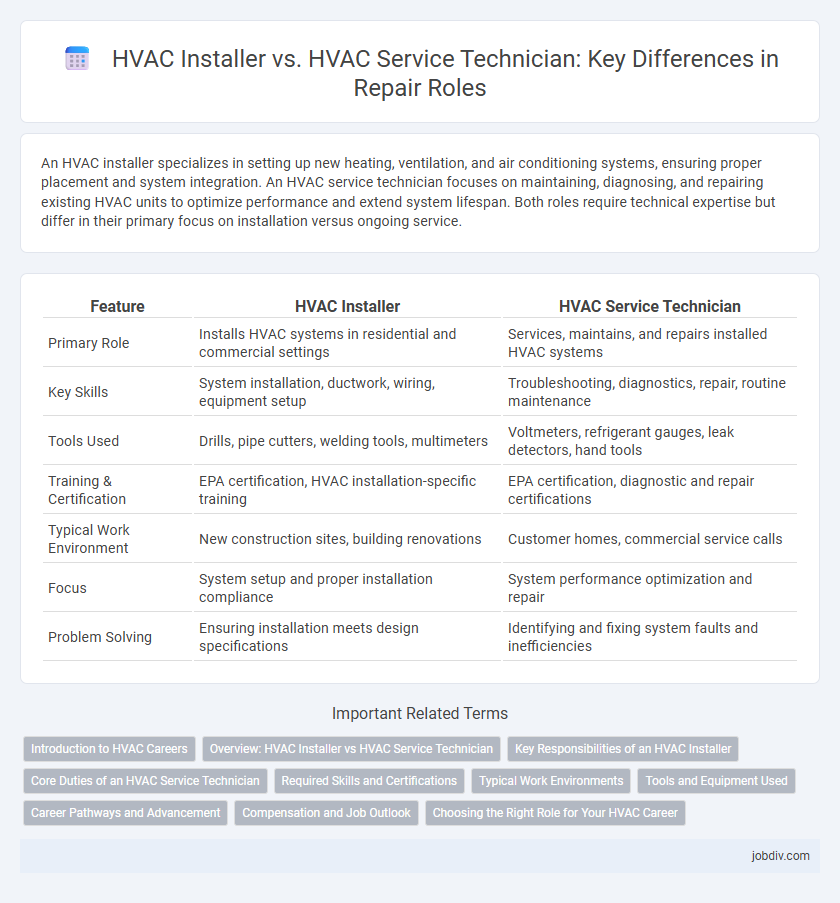An HVAC installer specializes in setting up new heating, ventilation, and air conditioning systems, ensuring proper placement and system integration. An HVAC service technician focuses on maintaining, diagnosing, and repairing existing HVAC units to optimize performance and extend system lifespan. Both roles require technical expertise but differ in their primary focus on installation versus ongoing service.
Table of Comparison
| Feature | HVAC Installer | HVAC Service Technician |
|---|---|---|
| Primary Role | Installs HVAC systems in residential and commercial settings | Services, maintains, and repairs installed HVAC systems |
| Key Skills | System installation, ductwork, wiring, equipment setup | Troubleshooting, diagnostics, repair, routine maintenance |
| Tools Used | Drills, pipe cutters, welding tools, multimeters | Voltmeters, refrigerant gauges, leak detectors, hand tools |
| Training & Certification | EPA certification, HVAC installation-specific training | EPA certification, diagnostic and repair certifications |
| Typical Work Environment | New construction sites, building renovations | Customer homes, commercial service calls |
| Focus | System setup and proper installation compliance | System performance optimization and repair |
| Problem Solving | Ensuring installation meets design specifications | Identifying and fixing system faults and inefficiencies |
Introduction to HVAC Careers
HVAC installers specialize in setting up heating, ventilation, and air conditioning systems, ensuring proper placement and connection according to building codes. HVAC service technicians focus on diagnosing, repairing, and maintaining existing HVAC equipment to optimize performance and energy efficiency. Both careers require knowledge of electrical systems, refrigeration cycles, and safety protocols, making them essential roles in the HVAC industry.
Overview: HVAC Installer vs HVAC Service Technician
HVAC installers specialize in setting up heating, ventilation, and air conditioning systems, ensuring proper installation and compliance with building codes. HVAC service technicians focus on diagnosing, repairing, and maintaining existing HVAC systems to optimize performance and extend equipment lifespan. Both roles require knowledge of HVAC components, but installers emphasize system assembly while technicians prioritize troubleshooting and repair.
Key Responsibilities of an HVAC Installer
HVAC installers specialize in assembling, positioning, and securing heating, ventilation, and air conditioning systems in new construction or retrofit projects, ensuring compliance with blueprints and safety codes. They are responsible for measuring and cutting ductwork, setting up wiring and piping, and testing system pressures and calibrations for optimal performance. Their role demands proficiency in reading technical diagrams and coordinating with construction teams to guarantee efficient system installation.
Core Duties of an HVAC Service Technician
HVAC Service Technicians specialize in diagnosing, repairing, and maintaining heating, ventilation, and air conditioning systems to ensure optimal performance and energy efficiency. Their core duties include troubleshooting system malfunctions, performing routine inspections, and replacing faulty components such as compressors, thermostats, and electrical wiring. Skilled in interpreting technical manuals and using diagnostic tools, HVAC Service Technicians also ensure compliance with safety standards and regulatory requirements during all repair tasks.
Required Skills and Certifications
HVAC installers require expertise in system layout, ductwork assembly, and adherence to local building codes, often needing certifications such as EPA Section 608 for handling refrigerants. HVAC service technicians must possess diagnostic skills for troubleshooting complex HVAC systems and typically hold certifications in electrical systems and specific manufacturer training. Both roles benefit from knowledge of safety regulations and proficiency in using specialized tools for efficient repair and installation.
Typical Work Environments
HVAC installers typically work in new construction sites, residential buildings, and commercial properties where they install heating, ventilation, and air conditioning systems according to blueprints and manufacturers' specifications. HVAC service technicians usually perform maintenance, repairs, and system diagnostics inside existing buildings, often working in residential homes, office complexes, and industrial facilities. Both roles require the ability to work in confined spaces, on ladders, and in varying weather conditions due to the diverse locations and physical demands of HVAC systems.
Tools and Equipment Used
HVAC Installers primarily use hand tools such as pipe wrenches, tubing cutters, and power drills to assemble and install heating, ventilation, and air conditioning systems. HVAC Service Technicians rely heavily on diagnostic equipment like multimeters, refrigerant recovery machines, and leak detectors to troubleshoot and maintain HVAC units. Both roles require an understanding of specialized gauges and safety devices, but technicians typically use more advanced electronic testing tools to ensure optimal system performance.
Career Pathways and Advancement
HVAC installers primarily focus on system setup and equipment installation, often starting their careers as apprentices before advancing to supervisory roles. HVAC service technicians specialize in maintenance, diagnostics, and repairs, with career growth opportunities including certification as master technicians or transition into specialized fields like refrigeration or energy management. Both pathways offer advancement through gaining industry certifications such as EPA Section 608 and NATE, which enhance technical skills and increase job market competitiveness.
Compensation and Job Outlook
HVAC installers typically earn an average salary ranging from $40,000 to $60,000 annually, reflecting entry-level positions focused on equipment installation, while HVAC service technicians often command higher pay, between $45,000 and $70,000, due to specialized skills in diagnostics and repairs. Job growth for HVAC service technicians is projected at 4% over the next decade, slightly faster than the 3% growth expected for installers, driven by increasing demand for maintenance and energy-efficient system upgrades. Both roles benefit from apprenticeship programs and EPA certification, which can enhance earning potential and job stability in the competitive HVAC industry.
Choosing the Right Role for Your HVAC Career
HVAC installers specialize in setting up heating, ventilation, and air conditioning systems, requiring strong skills in system layout, equipment assembly, and initial testing. HVAC service technicians focus on diagnosing, maintaining, and repairing existing HVAC systems, emphasizing troubleshooting, system optimization, and customer service. Choosing the right role depends on whether you prefer hands-on installation work or ongoing technical support and system maintenance within the HVAC industry.
HVAC Installer vs HVAC Service Technician Infographic

 jobdiv.com
jobdiv.com